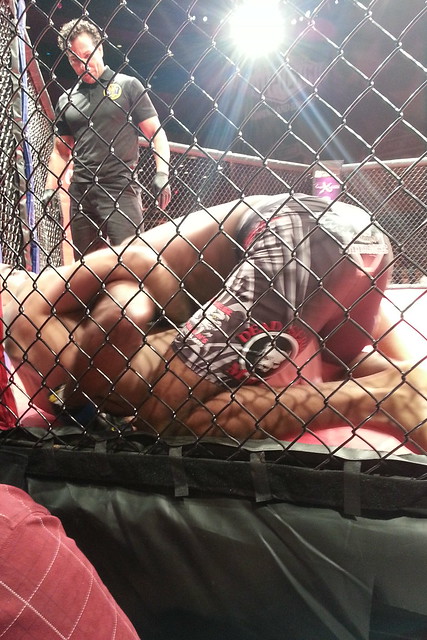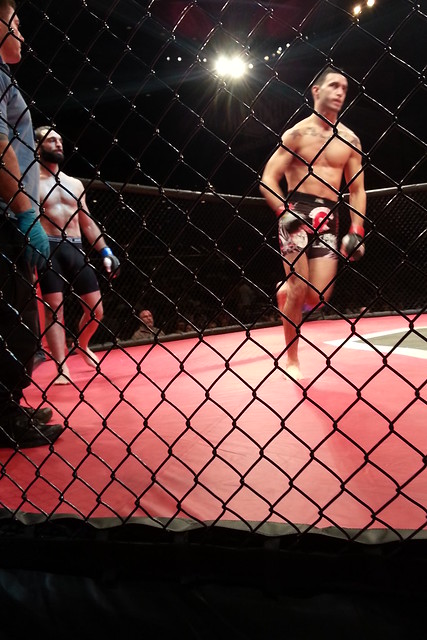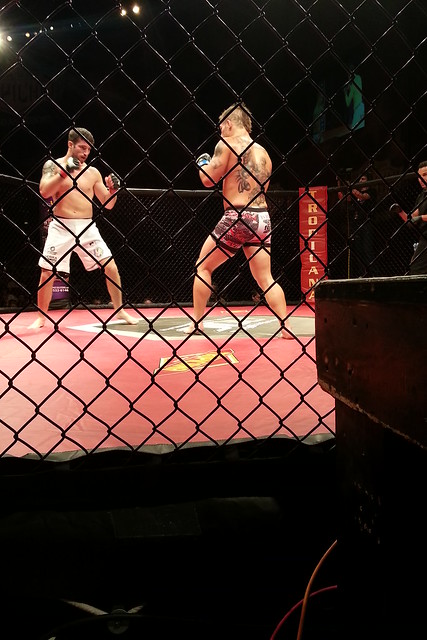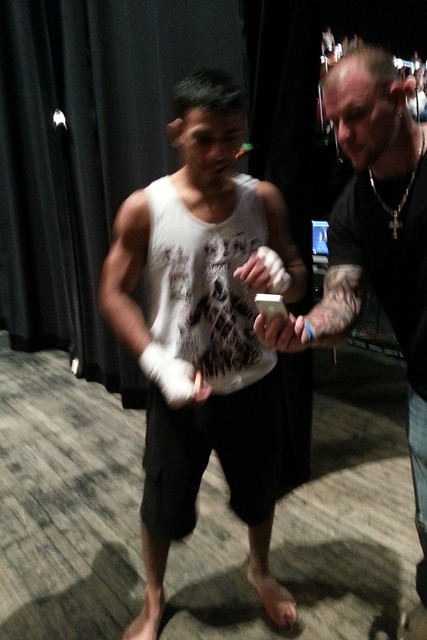I walked in to the Tropicana to cover the Ring of Combat show on September 19th not knowing what to expect. I’ve followed MMA for years, since the early days of the Zuffa takeover of the UFC. To finally cover a live MMA show that had produced so many legends was almost surreal. I wandered through the Tropicana an hour before the show started and finally entered the almost-empty arena. Friends, family, and teammates were trickling in, sporting Tiger Schulmann, Serra-Longo, Renzo Gracie, and a variety of other team names across their shirts, each hoping their teammate or instructor would bring home the “W”.
As I walked through the locker rooms adorned with a press pass and clumsily large notebook, I shyly introduced myself to some of the coaches. Some I had trained with in the past, while others I had watched from afar as their careers blossomed in the Northeast circuit. As infamous coaches like Ray Longo and Ricardo Almeida sauntered around the basement of the Tropicana, it comes as no surprise that so many fighters now in the UFC got their start at this promotion.
When I say I sat cageside, I mean literally next to the cage, sandwiched between a judge and a stool for the photographer. I was as close as you could be without being a referee or a fighter. I was far away from the sea of supporters, shiny Affliction shirts, tattoo encrusted “tough guys”, and family members cringing at the thought of their own flesh and blood getting in to the cage. Instead of watching MMA in a crowded bar with several drunken fans yelling at the screen, I was right near the eye of the storm.

Stephen Regman takes down Eddie Lenoci in the first fight of the night
I knew, to some degree, about one third of the guys on the card. I had friends in common with some of the fighters, others I had trained with or shared the same team name, and a there were a few whose career I had followed on the local circuit. As I sat cageside, I had to throw all biases aside in writing about the match, and could easily see why a mixed martial arts judge should not oversee a fight where a teammate or student is competing. Interesting note: at the end of each round, each judge hands their score to the referee.
In the second fight, I watched an old teammate make his professional debut. Cody Mooney is in his early twenties; he’s earnest without being naive, confident without being cocky. With a smile on his face, Cody told me to not interview him after the fight; while he remains calm before the storm, he ends up puking backstage, win or lose. I watched his coaches and my former instructors yell out instructions to him; they told him when to go for a takedown, when to throw a combination, and what he should be going for. Their words were simply the verbal manifestation of thousands of repetitions that had been performed in the gym, far away from the walls of the cage and the doors of the Tropicana. Like all coaches, they wanted Cody to unleash his skills inside the cage, to finally execute the combinations he had practiced hundreds of times before. Punching combinations, the timing of a single leg takedown, and the intricate grappling transitions all needed to come together on stage. I watched intently as Cody’s bout went in to a third round to determine the winner. While I never saw Cody lose his composure in the cage, I don’t think I even saw him flinch, he ended up losing a tough decision to his opponent.

Cody Mooney, in the white shorts, fought a three round fight in his pro debut
Cody and I have probably exchanged less than a dozen words, but watching someone lose in the cage, especially when you know how hard they’ve been training, is heartbreaking. And as the fights went on, I continued to feel overjoyed when someone won, but still crushed when they lost, even if I didn’t know them personally.
But why? It isn’t all that common for MMA fans to care about the loser in the fight unless it’s a friend or personal favorite.
Right?
There are many times where fans almost revel in the loss of a fighter, like when a cocky fighter gets knocked out or when someone gets “exposed.” There are many fans itching to see Floyd Mayweather knocked out, and a sizeable portion of MMA fans laughed off the loss of UFC great Anderson Silva after his incessant clowning and disrespectful attitude resulted in him getting knocked out. After sitting cageside and seeing all parties involved in the fight, it would be tough for me, barring extreme circumstances, to ever revel in someone’s loss.
One fighter I spoke to, Ashure Elbanna, teaches Brazilian Jiu Jitsu to a friend of mine at his school in Sayreville, New Jersey. This was only his second professional fight, but he grinned as he assured me that his opponent had never fought anyone like him before. After a back-and-forth battle, Elbanna ended up losing the fight to Shane Burgos, a Tiger Schulmann fighter who went undefeated as an amateur and stands at a whopping 6 feet tall in the 145 pound division. Does Elbanna’s loss make him a bad fighter? Absolutely not. I saw his coaches, an all-star corner featuring UFC veteran Dante Rivera, boxing great “Sizzlin” Sal Lopez, and Brazilian Jiu Jitsu black belt Josef “Ze Cobra” Manuel (not present at the event, but he is Elbanna’s jiu jitsu coach). He clearly has the tools to succeed, and I imagine he will be back in the winning column soon enough. Ashure, like most of the fighters on this card, was not a wannabe tough guy; he is a fighter who is green but growing.

Ashure Elbanna, on the left, watches as his opponent, Shane Burgos, enters the cage
I continued to watch the card, as James Jenkins from team Serra/Longo submitted his opponent, showcasing the ground game his team is so well known for. I gritted my teeth as Ricardo Almeida prodigy Frankie Perez crumpled to the cage floor from an initial punch, but came back for a vicious submission victory, a choke that put his opponent to sleep. The 24 year old Perez was greeted outside of the cage by screaming teammates and coaches, who all treated Frankie like he was family.
I kept my eyes peeled for the final two bouts, as Long Island’s Tom English took on Levan Makashivili. Throughout the evening, I kept hearing murmurs about how English was supposed to be the next big thing, while others joked about “that guy with the long name.” Makashvili surprised us all when he knocked out the Bellmore Kickboxing Academy representative in spectacular fashion. I watched English raise his head gently off the canvas just a few feet from where I was sitting, but in the corner of my eye, I could see the elated Levan, celebrating in a victory that many thought he couldn’t have. I saw the highs and lows of combat in one stunning picture, an artistic portrait of the emotions erupt at the end of a fight.
And then, the heavyweight title fight. As Brendan Barrett almost effortlessly finished his opponent via technical knockout in the first round, I couldn’t help but feel elated for Barrett, who was once a four fight losing streak in the promotion, albeit against guys like UFC veterans Costas Phillipou and Ricardo Romero. Years ago, you wouldn’t have seen a heavyweight fight like this even in the UFC; to see this level of heavyweight talent at a local show is a true testament to how far MMA has come.
Despite all the bouts I just mentioned, Pat DeFranco vs. Adam Townsend intrigued me the most. I watched as DeFranco fought a back-and-forth yet clear cut decision against Adam Townsend, who had flown all the way up from Mississippi. After the fight was over, I saw Pat by the stage, a baseball cap casting a small shadow over his lightly bruised face, a face that was tired but elated at the victory. When I complimented him on his fight, his face lit up as he said “Really?! You thought it was entertaining? Thank you so much.”
So why did I care about Pat’s fight? Because it was his reaction that made me realize that the local rising stars do not get much support outside of their team, that true recognition from the MMA world only comes at the top.

Pat DeFranco, in the white shorts, won a decision victory over Mississippi’s Adam Townsend
There are no outside fans lining up for autographs, no big sponsor checks, no press conference, and no photo shoots. The road to the top is paved with sacrifice, it’s paved with blood, sweat, tears, stitches, and held together by hand wraps, gloves, and mouth guards. It’s no wonder that many fighters treat their team like their family, because that’s their primary support, the main driving force that not only physically prepares them for competition, but mentally and emotionally supports them in their highs and lows.
After wandering around backstage that night combined with years of speaking and training under coaches from several teams, you hear about the sacrifices some of these fighters have made. Training several times a day in kickboxing, grappling, and strength and conditioning are what everyone has to do to succeed, but at the beginning stages, most of these fighters are balancing other jobs, sometimes school, and occasionally the task of providing for one’s family.
The emotions do not stop and end with the fighters themselves. The coaches are as immersed as their students in the fight. I saw each coach express genuine happiness or sadness in victory and defeat, the kind of emotion you see on a parent when their kid comes home with a grin and their first A+ in hand or tears in their eyes after being bulled in school. The investment in the fight is two-fold; while the fighter puts it on the line in the cage, the coach carefully molds each fighter in to the kind of person who can cast emotions aside enough to get in the cage with someone else and wage war. The coach who can mold a once out of shape kid in to a disciplined, lean, in-shape and motivated fighter, like Julio Arce. Arce fights under the Tiger Schulmann banner, and was once an overweight kid before he started training. Arce made his amateur MMA debut at the tender age of 18, and has yet to lose a bout in professional MMA, kickboxing, or boxing. I watched him unleash a storm of calculated aggression against his opponent, who could not get a punch or takedown in during the duration of the fight. As Arce cheered his victory in the cage, he spoke excitedly with his coaches and a lone reporter after the fight was over. “Your training was way tougher than that!” exclaimed Schulmann as Arce bounced up-and-down, still barefoot from the fight but with no scratches on him, barring his perpetual cauliflower ear.

A blurry Julio Arce about to take a picture with a fan
Being a MMA coach is not a ticket to success or riches. For some, it is a way of giving back to the martial arts, a way to continue their role in the sport after hanging up the gloves. These coaches often make money by running academies that cater not only to aspiring professional MMA athletes, but also to clients who want to simply learn the art or to just get in shape. It is these clients that provide the livelihood for the coaches; cornering a fighter is done out of a sense of investment, a sense of pride and confidence in the rising stars of the sport of mixed martial arts.
Knowing all of this and sitting cageside without any distractions has made me less of a critic, less quick to say that someone was “exposed” or to write off someone as a “has been”. The scattering of background information on each of the fighters added emotion to the battle going on in front of me. Not the kind of emotion that makes you love, hate, laugh, cry or cloud your judgment, but the kind that gives you a deeper understanding that the fight does not begin or end at the cage.That the explosion of a shin against someone’s midsection, the collision of knuckles against someone’s jaw, and the expertly timed chokes and joint locks are the validation of hundreds of hours of work behind the scenes, the kind of work that the time spent in the cage just a blip in the long, arduous hours of training that tax fighters physically, mentally, and emotionally. Not all fighters who enter the cage are destined to be great, but those who continue to train hard, train intelligently, and continue to put themselves on the front lines deserve respect that many tend to overlook in defeat.
It’s easy to forget that some losses aren’t due to a lack of skill, and while some of the losses at the Ring of Combat show were probably because the fighter was so early in his career or just wasn’t training the right way, but sometimes it’s just not your day. On that one day, your game plan didn’t click, on that one day you couldn’t pull the proverbial trigger. Ultimately, one’s success in MMA is defined by whether a fighter can push past moments like that to continue to learn and adapt to pursue successful MMA career.
As I watched each fighter leave the ring after each match, it was clear that the fight game is one of the most unforgiving businesses around, in and out of the ring. I watched one man who lost his fight collect a check that would make most wince, handed to him by a man in a suit as he sat alone on the stairs, bruised, shirtless, and bloodied with his head in his hands. I saw no teammates around him, only his girlfriend who walked him out of the venue. He’d forgotten to put in a request to have his gas money reimbursed, so his paltry show money would have to cover that as well. The winners of each fight gleefully ran to their supporters in the crowd and were showered with hugs, high-fives, and requests for autographs. I did not see a loser from any of the fights stick around; they disappeared from the venue that now held the memory of a loss instead of the euphoria that surrounds the beginning of battle.
MMA is a sport where even its biggest stars support fighters on the rise. I saw UFC and Pancrase legend Ricardo Almeida coach Frankie Perez to victory, Ultimate Fighter alumnus and Serra-Longo fighter Al Iaquinta cheer on and coach his teammates with the intensity of a football coach during the Super Bowl, and UFC veterans Dante Rivera and Jesse Taylor in the corners of their respective fighters. None of these guys were “too good” to come back to the small show, to help the new generation create a legacy of their own.
As I left the venue, I heard Dante Rivera laugh and tell his friends “You can’t kick me out of here, I’ve been at this place forever!” And in many ways, Dante is right. Once you’ve entered the realm of MMA, once you’ve stepped in to the cage to test yourself and tasted the levels of success possible in this sport, walking away is almost impossible. Everyone hangs up their gloves at some point, but the spirit of combat never leaves them and lives on in the form of their other teammates that continue to pave the way.
Source: buddhasport.com


